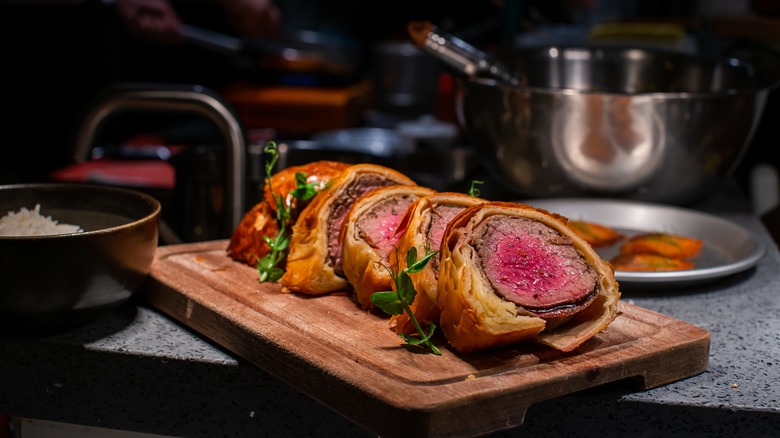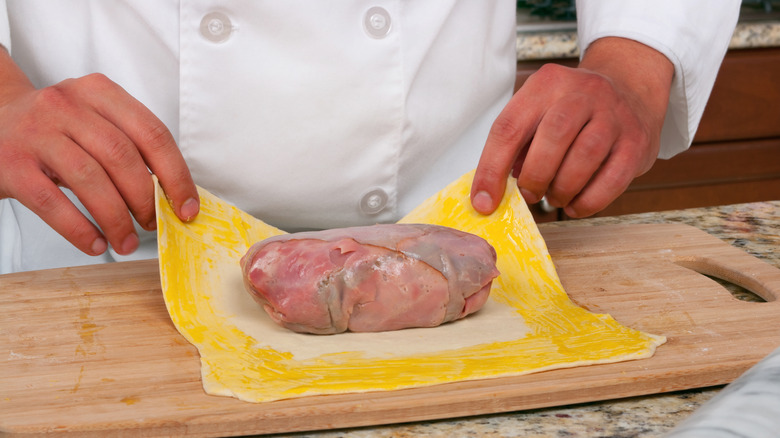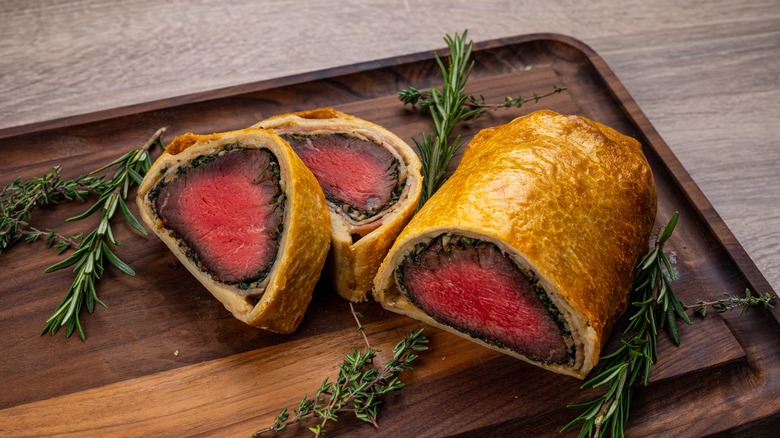Elevate Your Beef Wellington With One Crucial Extra Step
Tucking into a slice of beef Wellington will have you feeling like royalty. After all, the dish was reportedly invented and named for the Duke of Wellington to celebrate his defeat of Napoleon Bonaparte in 1815. As with many facets of the nobility, beef Wellington has become so steeped in lore that the thought of breaking from tradition is abhorrent to some. Its status as a British classic is unquestionable, but that doesn't mean there isn't room for change.
For many people, the modern perception of beef Wellington has largely been shaped by one culinary figure: Gordon Ramsay. The world-famous chef has won Michelin stars (and lost Michelin stars) in a restaurant empire largely built on this signature dish. Ramsay's beef Wellington recipe is the stuff of legend, but it can present a challenge to the home cook, particularly when it comes to the puff pastry shell turning soggy. That's where another celebrity chef can help us out.
J. Kenji López-Alt isn't afraid to challenge the culinary status quo. From hosting an 'anti-cooking show' to busting food myths through science, he's always looking for smarter ways to cook. To fix the issue of soggy puff pastry ruining beef Wellington, he turns to a simple, store-bought ingredient: Phyllo dough.
Why beef Wellington gets soggy
Puff pastry needs to be crispy, but beef Wellington is packed with moist ingredients that can turn everything soggy. The biggest issue is the mushroom duxelle, a coarse paste of mushrooms and herbs spread between the beef tenderloin and its shell. As the mushrooms cook, they leak a good deal of moisture. Some recipes for Wellington add foie gras, although this isn't as common in modern recipes like Gordon Ramsay's, perhaps because foie gras is illegal in many countries. If you do choose to add this ultra-luxe ingredient, however, it will leak a lot of fat, further adding to the moisture.
Most Wellington recipes attempt to hold back all the liquid by adding layers of prosciutto and crepes between the duxelle and the puff pastry. This is the Ramsay approach that so many try to emulate, but J. Kenji López-Alt finds that neither prosciutto nor crepes are effective enough at stopping leakage. Writing for Serious Eats, he notes that the fat in prosciutto actually increases the moisture level and that crepes are so delicate that liquid will simply leak right through them. Plus, making crepes adds more work to an already complex recipe. Instead, López-Alt recommends swapping the crepes for a sheet of phyllo dough, which effectively holds back moisture while taking a back seat to the stronger flavors in the dish.
Tips for making the perfect beef Wellington with phyllo dough
Phyllo dough might seem like an odd addition to beef Wellington. It's the dough of ancient Greek pies and spanakopita, so what is it doing in a great British classic? Well, as unorthodox as it may seem, phyllo dough is actually the perfect substitute for the traditional crepe in beef Wellington. Each sheet of phyllo is paper thin, but strong enough to keep liquid from leaking through. The incredibly thin nature of phyllo dough means that you'll hardly even notice it in the final product, keeping the puff pastry texture undisturbed.
Plenty of people will tell you that working with phyllo dough is difficult, and it can be, but not in this instance. Many dishes using phyllo dough often call for many layers (think spanakopita). Stacking all these sheets neatly without them drying out (or getting stodgy) is a challenge, and you need to spread butter or oil between each layer to keep them from sticking. However, you only need one sheet of phyllo to make beef Wellington, so there's nothing to worry about.
When assembling this sturdier and reinforced yet still relatively easy beef Wellington, simply lay out a sheet of phyllo dough and layer slices of prosciutto on top. Spread the duxelle over the prosciutto and lay the beef tenderloin on top. Then roll the whole thing up, place it on a sheet of puff pastry, and roll it up one more time. Now you're ready for the oven.


